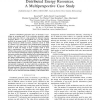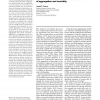588 search results - page 117 / 118 » Predicting Network Response Times Using Social Information |
TSP
2010
13 years 13 days ago
2010
Distributed averaging describes a class of network algorithms for the decentralized computation of aggregate statistics. Initially, each node has a scalar data value, and the goal...
WWW
2006
ACM
14 years 6 months ago
2006
ACM
The asymmetry of activity in virtual communities is of great interest. While participation in the activities of virtual communities is crucial for a community's survival and ...
HICSS
2008
IEEE
14 years 6 days ago
2008
IEEE
Abstract— Distributed generation (DG) of electricity is providing an increasing part of the worldwide electricity supply. At the same time, there is a big potential of demand res...
CORR
2010
Springer
13 years 5 months ago
2010
Springer
In P2P systems, large volumes of data are declustered naturally across a large number of peers. But it is very difficult to control the initial data distribution because every use...
AC
2003
Springer
13 years 11 months ago
2003
Springer
Abstract—The dynamics of the survival of recruiting fish are analyzed as evolving random processes of aggregation and mortality. The analyses draw on recent advances in the phys...


